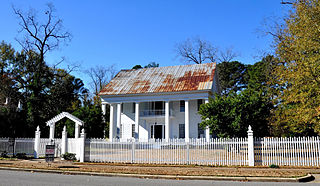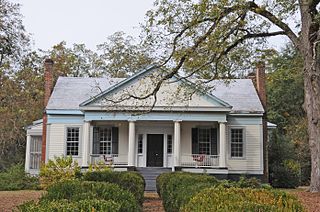
The David Rinehart Anthony House, also known as the Wynne House, was a historic vernacular Greek Revival style house in Eutaw, Alabama. The house was a two-story wood-framed building on a brick foundation. Four octagonal columns spanned the front portico. It was built in 1860 by David Rinehart Anthony. It was added to the National Register of Historic Places as a part of the Antebellum Homes in Eutaw Thematic Resource on April 2, 1982, due to its architectural significance. It has since been destroyed.
The Antebellum Homes in Eutaw Thematic Resource is a multiple property submission of houses that were listed together on the National Register of Historic Places. It covers twenty-three properties in Eutaw, Alabama, all built prior to the American Civil War.

The John Coleman House, also known as Grassdale, is a historic plantation house in Eutaw, Alabama, United States. The two-story wood-frame I-house was built by John Coleman from Edgefield, South Carolina, on property that he settled in 1819. Coleman held 75 slaves during the 1840 United States Census of Greene County. The house was placed on the National Register of Historic Places as part of the Antebellum Homes in Eutaw Thematic Resource on December 6, 1982, due to its architectural significance. Coleman family members, as well as many slaves, are buried in a cemetery close to the house. The house is currently used as a hunting lodge.

The Dr. Willis Meriwether House, also known as the Clark-Malone House, is a historic vernacular Greek Revival style house in Eutaw, Alabama, United States. The house is a two-story wood-framed building on a brick foundation, six square box columns span the front portico. It was built in 1856 by Dr. Willis Meriwether. The house was recorded by the Historic American Buildings Survey in 1934. It was added to the National Register of Historic Places as a part of the Antebellum Homes in Eutaw Thematic Resource on April 2, 1982, due to its architectural significance.

The William Perkins House, now known as the Freemount, is a historic Greek Revival style house in Eutaw, Alabama, United States. The house is a two-story wood-framed building on a raised brick foundation. Four monumental Ionic columns span the front portico. It was built in 1850 by William Perkins on the Eutaw Town Square. According to the 1850 U. S. Federal Census Slave Schedule, William Perkins' household in Greene County included eleven enslaved people, four women and seven men. Their ages ranged from 2–45 years old, and Mr. Perkins is listed as the slave owner. The house was recorded by the Historic American Buildings Survey in 1934. It was added to the National Register of Historic Places as a part of the Antebellum Homes in Eutaw Thematic Resource on April 2, 1982, due to its architectural significance. It is also listed on the Alabama Register of Landmarks and Heritage.

The Edwin Reese House, also known as the Reese-Phillips House, is a historic Greek Revival style house in Eutaw, Alabama, United States. The house is a two-story wood-frame building on a raised brick foundation. Four monumental Ionic columns span the front portico. It was built from 1856 to 1859 by Edwin Reese. The house was recorded by the Historic American Buildings Survey in 1936. It was listed on the Alabama Register of Landmarks and Heritage on October 17, 1980. It was added to the National Register of Historic Places as a part of the Antebellum Homes in Eutaw Thematic Resource on April 2, 1982, due to its architectural significance.

The Asa White House, also known as the White-McGiffert House, is a historic house in Eutaw, Alabama, United States. It was built in 1838 by Asa White, one of Greene County's earliest settlers. Eutaw was established on property owned by Asa White. He conveyed 20 acres (8.1 ha) to the newly established county seat in 1838 for the building of a courthouse, civic buildings, and a commercial district. He then sold residential lots to individuals. His house is a two-story frame building. It was built in the Federal style and later altered with the addition of Greek Revival-influenced details. The house was recorded by the Historic American Buildings Survey in 1936. It was added to the National Register of Historic Places as a part of the Antebellum Homes in Eutaw Thematic Resource on April 2, 1982, due to its architectural significance.

The Catlin Wilson House, also known as the Murphy Dunlap House, is a historic Greek Revival style house in Eutaw, Alabama, United States. The one-story wood-framed building was built in 1844. A pedimented front portico with four Doric columns covers the three central bays of the front facade. The house was recorded by the Historic American Buildings Survey in 1936. It was listed on the Alabama Register of Landmarks and Heritage on November 5, 1976. It was subsequently added to the National Register of Historic Places as a part of the Antebellum Homes in Eutaw Thematic Resource on April 2, 1982, due to its architectural significance.

The Gustave Braune House is a historic house at 236 Prairie Street in Eutaw, Alabama.

The Samuel W. Cockrell House is a historic antebellum house in Eutaw, Alabama, United States. It was placed on the National Register of Historic Places as part of the Antebellum Homes in Eutaw Thematic Resource on December 6, 1982, due to its architectural significance.

Everhope, known throughout most of its history as the Captain Nathan Carpenter House and more recently as Twin Oaks Plantation, is a historic plantation house near Eutaw, Alabama. Completed in 1853 for Nathan Mullin Carpenter, it is listed on the National Register of Historic Places and Alabama Register of Landmarks and Heritage due to its architectural and historical significance.

The Attoway R. Davis Home, also known as the Attoway Davis Cottage, is a historic house in Eutaw, Alabama, United States. The main block is a two-story I-house, built in 1817. It is the oldest surviving house in Eutaw. Directly in front of this main block is a two-room cottage, built in 1840. The rear of the cottage was later connected directly to the front of the main block. A physician built a one-room office on the grounds in 1850; it was later attached to the side of the two-room cottage. The house was placed on the National Register of Historic Places as part of the Antebellum Homes in Eutaw Thematic Resource on April 2, 1982, due to its architectural significance. It was restored by Ralph and Diana Liverman and now serves as a bed and breakfast.
The John W. Elliott House is a historic house in Eutaw, Alabama. The Creole cottage style structure was built in 1850 by Jesse Gibson for John Williams Elliott, a watchmaker and jeweler. Elliott was born in 1814 in Litchfield County, Connecticut. He migrated to Eutaw around 1840. Elliott married Louisa Elizabeth Towner, a teacher and native of Rutland County, Vermont, in 1843. They had three children, all born and raised in Eutaw. Louisa died in 1853. John then married Blanche Smith Chapman, a native of Virginia, in 1858. The Elliott family left Eutaw prior to the outbreak of the American Civil War and relocated to Brooklyn, New York, where John Elliott died in 1888. The house was placed on the National Register of Historic Places as part of the Antebellum Homes in Eutaw Thematic Resource on April 2, 1982, due to its architectural significance. It has been moved elsewhere since listing. The site is now a parking lot.

The First Presbyterian Church is a historic Greek Revival church building in Eutaw, Alabama. The two-story frame structure was built for the local Presbyterian congregation in 1851 by David R. Anthony. Anthony was a local contractor who constructed many of Eutaw's antebellum buildings. The congregation was organized by the Tuscaloosa Presbytery in 1824 as the Mesopotamia Presbyterian Church. John H. Gray served as the first minister from 1826 until 1836. The church was added to the National Register of Historic Places on December 16, 1974, due to its architectural and historical significance. The church is a member of the Presbyterian Church in America.

Glenville, also known as the Jincy P. Glenn House, is a historic house in Eutaw, Alabama. The structure was built in the mid-1840s for Jincy Pride Glenn. She was born in Virginia in 1776. Jincy Glenn was the widow of Daniel Glenn of Union County, South Carolina. The house was placed on the National Register of Historic Places as part of the Antebellum Homes in Eutaw Thematic Resource on April 2, 1982, due to its architectural significance.
The Benjamin D. Gullett House is a historic structure in Eutaw, Alabama. The house was placed on the National Register of Historic Places as part of the Antebellum Homes in Eutaw Thematic Resource on April 2, 1982, due to its architectural significance.

The Stephen Fowler Hale House, also known as the Hale-Jarvis-Trotter House, is a historic structure in Eutaw, Alabama. The house was added to the Alabama Register of Landmarks and Heritage on November 30, 1977, and subsequently placed on the National Register of Historic Places on April 2, 1982, due to its architectural significance. It is a part of the Antebellum Homes in Eutaw Thematic Resource.

The William C. Jones House, also known as the Archibald-Tuck House, is a historic structure in Eutaw, Alabama. The house was placed on the National Register of Historic Places as part of the Antebellum Homes in Eutaw Thematic Resource on April 2, 1982, due to its architectural significance.
The Samuel R. Murphy House, also known as the Winfield Scott Bird House, is a historic structure in Eutaw, Alabama. The one-story Greek Revival house was built in the 1850s by Samuel R. Murphy, in part with materials salvaged from the old Mesopotamia Presbyterian Church. It was purchased by Winfield Scott Bird in 1869. The house was placed on the National Register of Historic Places as part of the Antebellum Homes in Eutaw Thematic Resource on April 2, 1982, due to its architectural significance.

The William A. Rogers House is a historic house in Eutaw, Alabama. The one-story wood-frame house was built in stages from the late 1840s to the 1850s. It features Greek Revival-style architecture, with a pedimented tetrastyle portico fronting the central three bays of the five-bay main facade. It was added to the National Register of Historic Places as part of the Antebellum Homes in Eutaw Thematic Resource on April 2, 1982.


















